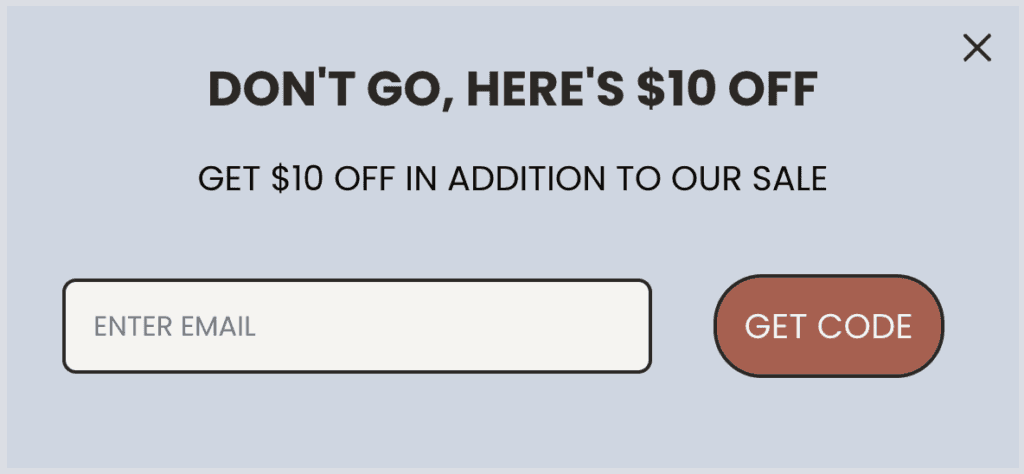High bounce rates can be frustrating, as they signal that your website needs to do a better job of converting visitors into paying customers. However, with exit intent popups, this job becomes easier.
Think of these popups as a last-ditch attempt to lure your website’s visitors into staying a bit longer by offering them irresistible incentives such as a discount or an exclusive offer.
The average time a person spends on a web page is 52 seconds. Of course, this isn’t a lot of time, but with an exit strategy coupon, you can extend it a bit longer. And most of the time, that tad bit of extra time is all you need for the conversion.
In this post, we’ll explore the exit intent popups in detail and go over the psychology of why they work, and actionable tips on implementing them effectively on your website.
What Are Exit Intent Popup Coupons

As the name implies, an exit intent popup is a marketing tool designed to detect when a website visitor is about to click their browser’s close button or navigate away from your web page.
In that instance, it automatically activates by popping up with a message that convinces the visitor to take a specific action, such as making a purchase or signing up for a newsletter.
Let’s be honest here. No one wants to feel pressured to purchase something or see an exit strategy coupon and think, “This is cringe!” before heading straight for the exit button.
For example, you can offer a related resource, such as an ebook, to visitors trying to find out more about a product on your website. You could also ask them to subscribe for daily or weekly information about that product.
In doing so, the visitor will value your website as a trusted source of information, and you, in turn, will have access to valuable information, such as the email address they used for subscription.
How Exit Intent Popup Coupons Work

Exit intent popups use advanced exit-intent technology to detect when visitors are about to leave your website’s web page.
Statistically speaking, the average popup conversion rate is 11.09%, and the top 10 highest-performing popups have an impressive average conversion rate of 42.35%.
Looking at these figures, it’s clear that if done right, your exit strategy coupon popups can do impressive numbers, engaging and converting visitors from your site.
Meanwhile, exit strategy coupon popups are proactive helpers who track visitors’ exit behavior and step in at the right moment to encourage them to stay or take action.
Their ability to detect is based on triggers and timing mechanisms, which activate them just in time to capture the visitor’s attention before they exit.
These exit strategy coupon popups work in various ways and can be used to engage visitors based on your intent or strategy. Here are typical examples below:
Mouse Movement Detection
This is the most common trigger for exit strategy coupons. You can activate this on your website when a visitor’s cursor moves toward their browser’s close button or other areas, such as the back button or the URL bar.
Inactivity Timers
You can set your exit-intent popup to activate after a certain period of inactivity on the page. If the visitor hasn’t clicked or scrolled for a specified amount of time, the popup can appear to re-engage them.
Scroll-Based Triggers
Another trigger is the visitor’s scroll depth on the page. For example, you can set your exit strategy coupons to display if a visitor scrolls past a certain percentage of your web page and then starts moving toward the exit, encouraging further engagement.
Multiple Trigger Options
You can combine multiple triggers, such as mouse movement with timed inactivity, to optimize when the exit strategy coupon popup is shown. This maximizes the chances of keeping visitors on the site without appearing too aggressive.
Customization and Timing
To ensure your website’s popup is effective and doesn’t disrupt the user experience, you can customize the timing and frequency so they aren’t triggered too soon or too often, which might annoy visitors.
Types of Exit Intent Popups
Exit intent popup strategies are vital for converting customers and boosting engagement on your site. However, they are not all the same, as they’re used for different purposes and intents.
Let’s closely examine them so you can make the best choice for your business website.
Percentage Off Exit Intent Popup Coupons
One of the most popular types, this coupon offers visitors a percentage discount on their total purchase if they stay and complete the transaction.
They work well when you want to encourage customers to make immediate purchases, especially for bigger items where a percentage discount might seem more attractive.
Dollar Off Coupons
Dollar-off coupons offer a fixed dollar amount of the total price. They’re effective when offering a clear, tangible benefit, particularly for products with mid-range pricing where a specific dollar discount may appear more substantial than a percentage-based offer.
Conditional Coupons

These coupons are triggered based on certain conditions, such as a minimum purchase requirement or for first-time buyers.
They increase the average order value by setting a minimum spending threshold or encouraging new customer conversions.
Limited-Time Coupons

These coupons create a sense of urgency by offering a discount only for a limited time. They tap into FOMO (Fear of Missing Out) and can significantly boost conversions by pushing visitors to take action quickly.
Email Capture with Coupon Offers

This coupon encourages visitors to enter their email addresses in exchange for a discount code. It can help you grow your email list while incentivizing visitors to stay engaged and shop.
The Psychology Behind Why Intent Popup Coupons Work

As humans, we’re highly psychological, and these coupons have been designed to take advantage of our innate behaviors, which is why they have proven very effective.
That said, let’s examine these psychological factors in depth to understand why they make exit strategy coupons highly effective.
Fear of Missing Out (FOMO)
The fear of missing out (FOMO) is simply the anxiety people feel when they miss out on a reward or offer that others might have capitalized on.
Most times, exit strategy coupons that use this psychological strategy are time-sensitive or exclusive. As humans, we might feel that we’d later regret it if we don’t take advantage of the opportunity there and then.
Also, our need for instant gratification and desire to get rewards can motivate people to stay and utilize the coupon, avoiding the regret of missing out on the offer.
The Reciprocity Principle
This is a classic case of people feeling obligated to return a favor when something is given to them. A boomerang, more or less!
For some visitors, when they come across an exit strategy coupon that offers something valuable, such as a discount or a special deal, upon leaving, the reciprocity principle automatically gets triggered, making them feel an unspoken moral obligation to return the favor.
As a business owner, you might see this type of exit strategy coupon as a marketing tactic. However, your visitors subconsciously feel like they owe your business something for offering them a discount, leading to higher conversion rates.
Social Proof
Ever heard of the bandwagon effect? Well, social proof operates based on the same principle.
Your visitors are more likely to take advantage of your exit strategy coupon if they know others are doing the same.
For example, if your coupon contains elements of social proof such as “100 people have used this coupon in the last hour! And you can as well!” visitors will perceive the coupon as popular and valuable, which can motivate them to utilize it and stay longer on your website.
Loss Aversion
This is a very persuasive tactic you can use to encourage your website visitors to stay longer and take action, perhaps by making a purchase or doing something similar if you run an e-commerce website.
An excellent example would be to let them know that they’ll miss out on a 20% discount if they leave your website without taking the offer.
When they come across such an exit strategy coupon, they will most likely check it out because they fear losing out on something more.
Confirmation Bias
This works in the opposite direction as you can use an exit strategy coupon to reaffirm the visitor’s decision to purchase your product rather than to persuade them to stay and get something in return.
So, if a website visitor has already decided to purchase headphones from your website but is hesitant or maybe still trying to decide whether to get them, you could create a coupon to reaffirm their belief that they are making the right choice.
The coupon could read: “You already know these are the best choice! Here’s an extra 10% off to make it even better. Don’t wait – complete your purchase now and join the thousands who’ve already upgraded their listening experience!”
When they see this message, it will reassure them, and they will eventually make a purchase.
Best Practices for Exit Intent Popup Coupons
Even if you prepare the best popup coupons, they might not work if your strategy is poorly planned. That’s why we’ve compiled a list of the best practices you must follow to get the best results from your coupons.
Optimal Timing
Remember when you used to surf some websites, and the constant popup coupons and ads kept giving you hell and prevented you from reading the content on the websites?
We’re sure it was a pretty frustrating experience, and it probably made you spend less time on the website than you wanted to.
That’s what you get when you deploy an exit coupon popup with poor timing. Timing is essential because deploying popups too early can annoy users and lead to higher bounce rates, while deploying them too late may result in missed opportunities.
Testing and Optimization
Testing and optimization through A/B testing are essential because not all coupon popups work for all audiences. These tests can provide valuable insights into what design, copy, and offer work best for your website.
For example, one popup version might offer a percentage discount while another offers free shipping. By testing these variations, you can determine which offer will increase visitor engagement and lead to higher conversions.
Also, knowing the perfect place on your website to place the coupon popup and the colors and fonts to use should be part of the testing and optimization process so that the popup is both visually appealing and effective in grabbing attention.
Analytics and Tracking
The most effective way to ascertain the performance of your coupon popups is through analytics and tracking, using Google Analytics GA4.
By monitoring specific metrics such as bounce rates, time spent on site, conversions, and so on, you can tell if your popup is doing justice to your website.
If the popup increases bounce rates, it may not be as effective as you intend, and it might be time to review it.
Examples of Exit Strategy Coupon Popups You Can Create Using PopupAlly
We’ve been discussing exit strategy coupon popups all day long! Now, it’s time to get practical by showing you samples of some of the best exit strategy coupons you can create for your website.
Honestly, it’s simple!
You simply need to purchase the PopupAlly plan to have access to all the features you need to create engaging popups on your website.
That said, let’s take a look at some of the samples below:
Tried and True

You can use this popup to entice visitors to subscribe to your newsletter by presenting it as a final chance before they leave your website. It can emphasize the value of staying connected and receiving exclusive content or offers.
If your website prioritizes lead generation through email signups, then this is what you should definitely go for.
It’s also customizable, so you can edit the message and add your own. For example, you could add a new message that reads: “Wait!” Don’t miss out on exclusive weekly content and insider tips!” if you feel it’s more effective.
Simple Choice

If you’re a B2B business owner who offers services like digital marketing, sales optimization, or subscriber growth strategies, consider using this as an exit strategy coupon popup on your website.
This coupon popup can be a teaser for what your business can deliver, piquing the interest of businesses seeking these solutions.
Special Offer

This type of exit strategy coupon popup is suitable for abandoned cart recovery, which happens when visitors leave your website without completing their purchase.
By offering them a discount (20% in this case), you’re incentivizing them to stay and finish the transaction, especially if they’re on the fence about purchasing.
Common Pitfalls to Avoid While Creating Exit Intent Popup Coupons
Now that you are almost ready to create your exit intent popup coupons, we wanted to warn you about some common pitfalls one last time. By avoiding these mistakes, you’ll be able to stay ahead of your competitors and retain more web visitors.
- Triggering the popup too early: If the popup appears too soon before your visitors exit, it can be disruptive and may prematurely push them away from your website. Ensure the popup is triggered only when a visitor genuinely intends to leave.
- Using overly aggressive or intrusive designs: Flashy or intrusive popups with loud colors or animations can annoy visitors, causing them to leave faster. Keep the design clean and aligned with your brand’s look, ensuring it’s attention-grabbing without being overwhelming.
- Poor mobile optimization: If your popup isn’t mobile-friendly, it can negatively impact the experience of visitors who access your website through their mobile devices. Ensure the popup is responsive, easy to close, and displays correctly on all screen sizes.
- Asking for too much information: Long forms requiring too many details (e.g., name, phone number, address) can deter visitors from engaging with the popup. Keep it simple by asking only for essential information, like name and email.
- Overusing exit popups: If visitors see the same popup on every visit or multiple times during the same session, they’ll become frustrated. To maintain a positive user experience, limit how frequently the exit strategy popup appears.
- Making it difficult to close the popup: If visitors can’t easily close the popup, they might become frustrated and leave the site altogether. Always ensure there’s a visible “X” or close button, and never make it difficult to exit.
Conclusion
We hope this blog has helped you understand exit intent popup coupons, how they work and the types of exit strategy coupons. With the newfound knowledge, you’ll be able to understand what to look out for when designing them and the common pitfalls to avoid.
As with any marketing strategy, experimenting is key. Don’t be afraid to try different designs, offers, and messaging to find out what resonates most with your audience. Through A/B testing and refining your approach, you can optimize your popups for the best results.
Get PopupAlly today to create your own exit strategy coupon popups and see how they impact your business performance. With the right approach, exit strategy popups can become a powerful tool for driving growth and boosting sales.
We’d love to hear from you! Feel free to share your experiences with exit strategy coupon popups or ask questions about improving your site’s conversion rate.

